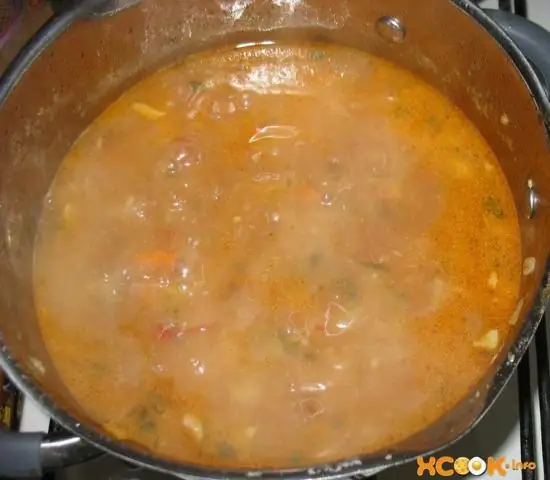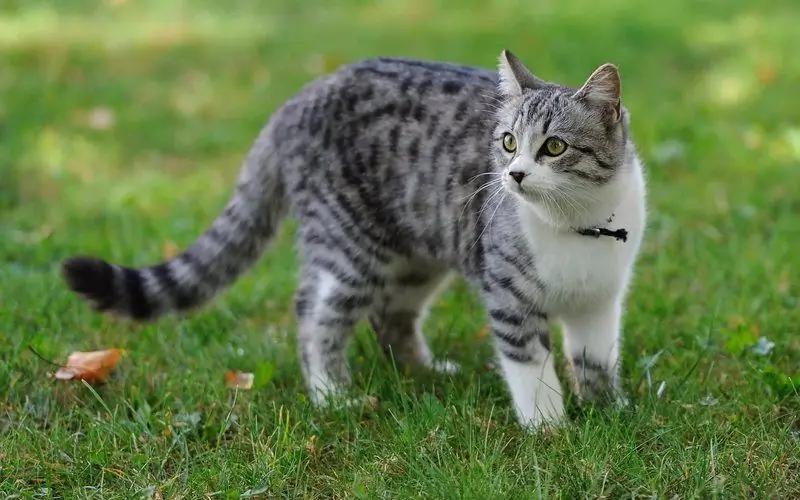
Table of contents:
- Author Bailey Albertson [email protected].
- Public 2023-12-17 12:53.
- Last modified 2025-01-23 12:41.
Thick soup or noodles with sauce: preparing delicious lagman

Lagman … A mysterious and incomprehensible word is called drawn noodles with a sauce of meat and vegetables. Anyone who has ever tried this dish does not need its advertising. And those who are going to do it for the first time will have an unforgettable journey into the world of Asian cuisine. Of course, it is better to try the dish in his homeland, from the professionals of national cuisine. But if this is not possible, try to cook it yourself at home. And step by step recipes with photos will help you master this art.
Content
- 1 In search of roots
- 2 Nutritional value and calorie content
-
3 The composition of the lagman, features of preparation and serving
-
3.1 Lagman noodles: thin thread
3.1.1 Video: how to make lagman noodles
- 3.2 Vazhda, kayla or sauce
- 3.3 Submission rules
-
-
4 Step-by-step recipes for making rich lagman at home (with photo)
- 4.1 The classic lagman recipe with lamb in a cauldron
-
4.2 Recipe from Stalik Khankishiev
4.2.1 Video: lagman from Stalik - master class
- 4.3 With eggplant and bell pepper
- 4.4 With zucchini and margelan radish
- 4.5 With chicken in a slow cooker
-
4.6 Vegetarian with beans
4.6.1 Video: how to cook Uyghur lagman
Looking for roots
Who would have thought that such a common dish as noodles is also popular in the East. Only it is called lagman there. According to one version, the dish appeared in China, according to another - in Japan, and from there it spread throughout Asia and the whole world.
Laghman is so popular that many people consider it a national dish. In some countries, it is served as a first course (thick soup), in others - as a second, noodles with meat and vegetable gravy. But the essence of the dish does not change from this: it is a base of noodles and a meat-vegetable part, which are prepared separately, and are combined when served. The dish can replace a whole meal, having the characteristics of both the first and second.

A good lagman can replace a two-course meal
The Uighurs, Uzbeks, Kyrgyz, Kazakhs, Tajiks, Dungans and other ethnic groups have their own lagman, despite minor differences in the recipe. The dish was most widespread in Central Asia and China.
Nutritional value and calorie content
This dish is very satisfying and nutritious, high in calories. The original recipe uses lamb meat, seasonal vegetables and homemade noodles. The soup version contains 120-130 kcal, the calorie content in the second course reaches 250 kcal per 100 g.
You can reduce the calorie content of a dish by replacing lamb with a more dietary meat - lean beef. It is better not to put potatoes in such a dish.
The content of proteins, fats, carbohydrates and vitamins depends on the type of meat and vegetables used. The only thing that is invariable in lagman is noodles.
The composition of the lagman, features of preparation and serving
Despite the variety of recipes for meat and vegetables, the flour component is always represented by homemade noodles. Trying to replace it with regular pasta will only give a rough idea of the taste of real lagman.
Lagman noodles: fine thread
For those who are not ready to spend a lot of time making homemade noodles, there is good news: you can buy them in the store. The popularity of the dish pushed the industry to produce this pasta.

Lagman noodles can now be purchased in the store
But if you want to taste real lagman, make your own noodles. The process is not fast, time consuming, and it requires skill, but your efforts will be rewarded with the indescribable taste of the finished dish.
Initially, only flour, water and salt were taken for noodles. Now more and more eggs are added to the dough, some types are made even without adding water.
The correct noodles for lagman are drawn. It has a round cross-section, is rolled out and pulled out with a long thread. It is this process that takes a lot of time and is difficult for novice cooks.
For the test you will need:
- vegetable oil - 200 ml;
- water - 1 tbsp.;
- eggs - 4 pcs.;
- flour - 6 tbsp.;
- salt - 1 tsp.
-
Mix the eggs, water, flour and salt into a tough dough.

Dough kneading Knead hard dough
-
Wrap in plastic wrap and leave to ripen.

Maturation of the dough Wrap the dough in foil and let it rest
- Slightly flatten into a layer, lubricate with vegetable oil.
- Fold in half, grease the top and sides with oil as well.
-
Cut into strips 1.5 cm wide, fold into a bag and leave to rest for another 15 minutes.

Dough slicing Grease the dough with butter, cut into strips
-
Take out the strips one at a time, roll them into a pencil-thick sausage.

Rolling flagella Roll a flagellum from each strip of dough
-
Place the sausages with a snail on a board, brush with oil and let stand under the film for another 15 minutes.

Dough snail Lubricate a plate or board with oil and arrange the flagella with a snail
-
Roll each sausage with your right hand, while stretching and twisting slightly with your left.

Rolling the noodles Roll the noodles out again while pulling them out
-
Fold the noodle strings in parallel, stretch them slightly with your hands and beat them on the table.

Noodle strings Gather the finished threads parallel to each other and lightly beat on the table
- The finished noodles should be 3-4 mm thick, it remains to boil them.
-
Dip the noodles in boiling salted water and cook for 3-5 minutes.

Cooking noodles Boil noodles in salted water
- Throw in a colander and rinse immediately with cold running water to rinse off excess flour.
There is also a simplified version - cut noodles. The dough for her is prepared according to the same recipe, rolled thinly and cut into thin strips. Which option to choose is a matter of taste.

If you have a noodle slicer it will make the task easier.
In Dungan cuisine, for lagman they take funchoza - thin noodles made from rice flour. You can use spaghetti or other types of long vermicelli, but it won't be quite lagman anymore.
Video: how to make lagman noodles
The sauce is prepared faster, its recipe provides more freedom of choice of products.
Vazhda, kayla or sauce
Vazhda or kayla is the meat and vegetable part. It is prepared separately, when serving, spread on top of the noodles and pour over the gravy
All products are first fried over high heat, then liquid is added and the sauce is simmered until the ingredients are tender. The amount of liquid varies depending on the recipe.
Traditionally, lagman is prepared with mutton. But if you do not like this meat or for some reason cannot use it, take another one. Most often they use beef, but veal, pork, chicken, turkey are also suitable.

The traditional meat for lagman is lamb
Vegetables are taken according to the season. These can be eggplants, onions, potatoes, carrots, bell peppers, green beans, and even daikon and radishes. Sometimes white cabbage is added - there are no restrictions, it all depends on the availability of vegetables.

The set of vegetables for lagman depends on the season
Traditional cooking utensils are a cauldron, preferably with a round bottom. It warms up evenly from all sides and keeps heat well. But such dishes are more suitable for open fire; at home, a cauldron with a flat bottom or a wok is used.
A modern alternative is the multicooker. Its bowl also warms up evenly from all sides and will successfully compete with the traditional cauldron.
The food is cut to approximately the same thickness for even frying. The amount of slicing depends on the recipe and consumer preferences.
Here's a variation on the lamb sauce:
- meat - 0.4 kg;
- potatoes - 3 pcs.;
- onions - 3 pcs.;
- tomatoes - 0.3 kg;
- carrots - 2 pcs.;
- sweet pepper - 3-4 pcs.;
- garlic - 1 head;
- vegetable oil;
- spice;
- greens.

The sauce is made from meat and seasonal vegetables
-
Wash the meat and clean it from films and fat.

Meat for lagman Remove films from meat
-
Cut into small cubes.

Sliced meat for the sauce Cut the meat into cubes
- Chop vegetables into strips, tomatoes into slices.
-
Heat oil in a cauldron or wok, fry the meat.

Roasting meat Fry the meat in hot oil
-
Place onions, carrots and peppers in succession, frying each type of vegetables.

Frying vegetables with meat in a cauldron Add vegetables in sequence and fry
- Salt the frying, season with pepper, cumin, star anise or other spices.
- Attach the potatoes, and after 10 minutes, the tomatoes.
- Reduce heat and simmer stew for 15 minutes.
-
Pour in enough water to make a sauce of the desired consistency and cook until the potatoes are tender.

Cooking sauce with potatoes Cook the sauce until the potatoes are done
- Chop the garlic, mix with hot red pepper, add to the finished gravy.
- Let the sauce steep for a few minutes and soak in garlic and serve, sprinkled with chopped herbs.
Submission rules
-
The food is served in bowls - deep oriental bowls.

Lagman in a bowl In the East, lagman is served in bowls
- First, put the noodles, on top of the meat with vegetables and sauce, sprinkle with plenty of herbs. Most often, dill and cilantro.
- Additionally, the table is served with garlic and hot pepper seasoning so that eaters can adjust the pungency to their liking.
- It is appropriate to prepare a light vegetable salad for the dish, for example, from celery.
- Lagman is eaten with a fork and spoon, according to the Eastern tradition, it is customary to serve bamboo sticks.
- Green tea is considered the best drink for lagman, the east does not like alcohol too much.
- And, of course, the dish will be tastier with fresh bread - Uzbek flatbreads, lavash.
Step-by-step recipes for making rich lagman at home (with photo)
It is customary to start a selection of recipes with a classic one. The problem is that the lagman does not have one, because the range of products used depends on the season, the area and the vegetables that grow on it. Here is a recipe with a minimum amount of ingredients, and you can already add seasonal vegetables to it.
Classic lagman recipe with lamb in a cauldron
- noodles - 0.8 kg;
- meat (lamb) - 0.7 kg;
- onions - 2 pcs.;
- carrots - 2-3 pcs.;
- tomatoes (or tomato paste) - 3-4 pcs.;
- potatoes - 4-5 pcs.;
- vegetable oil - 4 tbsp. l.;
- salt;
- pepper;
- greens (dill, parsley, rosemary, basil).

Cut products for lagman into cubes
-
Wash the food, cut the meat into small cubes, onion and potatoes into cubes, carrots into strips, tomatoes into slices.

Sliced products Slice the food for lagman
-
Heat the oil in a cauldron, fry the onions, meat, carrots one after the other until browning.

Roasting vegetables with meat Fry onions, meat, carrots
- Add tomatoes or tomato paste, simmer for 5 minutes.
- Pour in 1.5 liters of water, bring to a boil.
- Season with salt and pepper, reduce heat and cook for 15 minutes.
-
Dip the potatoes in the gravy, cook until tender.

Cooking lagman Add potatoes and cook until tender
-
Put finely chopped greens and bay leaves, turn off the heat, cover the cauldron with a lid, let it brew for 10 minutes.

Adding greenery Add greens last, turn off the heat
- Cook noodles according to the basic recipe or take ready-made and cook in a large amount of salted water.
-
Remove with a slotted spoon, rinse with running water.

Lagman noodles The noodles are boiled in salted water and then washed with running
-
Arrange the noodles in bowls or portioned plates, top with the meat and vegetables, and generously pour the sauce.

Lagman in a plate First put the noodles in the plate, and pour the sauce on top
- Serve with fresh chopped herbs, chopped garlic and hot peppers to taste.
As you know, oriental dishes are better prepared by oriental chefs.
Recipe from Stalik Khankishiev
This is one of the samples of an oriental dish that combines elements of Uzbek, Chinese and Italian cuisine. And one more confirmation that the essence of cooking is in creativity.
For noodles:
- eggs - 3 pcs.;
- flour - 0.33 kg;
- lamb broth - 1 l;
- meat (beef) - 0.6 kg;
- onions - 2 pcs.;
- carrots - 1 pc.;
- tomatoes - 1 pc;
- white cabbage - 0.3 kg;
- red radish - 2 pcs.;
- garlic - 1 head;
- celery - 1 pc.;
- soy sauce - 60 ml;
- turmeric - 1 tsp;
- cumin, coriander - 1/3 tsp each;
- red pepper - 1 tsp;
- hot pepper - 1 pc.;
- parsley;
- salt.
- Fry the lamb ribs and cook a strong broth.
-
Mix two eggs, one yolk, turmeric, a pinch of salt and flour into a tough dough.

Dough preparation Knead a tough dough from eggs, salt and flour, you can add turmeric
- Put it in a bag and let it rest for half an hour or an hour.
-
Divide the dough into two, roll out a thin layer from each.

Rolled dough Roll out the dough thinly
-
Cut into strips no more than 5 mm wide.

Noodle nests Cut the noodles into strips and roll into nests
- Roll the noodles into strips of nests and leave to dry.
- Wash the vegetables and cut: onions, carrots, celery, radishes - into strips, tomatoes - into slices, garlic - into slices, cabbage - into pieces.
-
Cut the meat into small cubes.

Meat cubes Cut the meat into small cubes
-
First fry the onion and garlic in hot oil, then add the beef to them. The meat should be crusty.

Bow with cauldron Fry the onion and garlic in hot oil
-
Add salt and spices.

Meat with onions in a cauldron Add meat to the onion and fry too
- Load carrots and celery into the cauldron, then cabbage.
- Cook for 10 minutes, then add the radish.
-
Now you can add tomatoes, parsley.

Adding tomatoes Attach tomatoes to the meat and mix
-
It remains to pour in the broth, add soy sauce or paste, hot pepper pod, season with paprika.

Soybean paste Add soy sauce or paste
- While the sauce is cooking, boil the noodles.
-
Arrange it on plates, cover with meat and vegetables, pour over the gravy.

Noodles in bowls First put the noodles in the bowls
Video: lagman from Stalik - master class
And in the fall, when the "blue" ones are ripe and the spicy spirit of chopped sweet pepper spreads throughout the house, it is a sin not to add these vegetables to your favorite dish. And even if instead of lamb there was only pork or even chicken in the refrigerator, vegetables and spices will give the dish the necessary oriental flavor.
With eggplant and bell pepper
- homemade or purchased noodles (linguini) - 0.6-0.8 kg;
- meat - 0.6 kg;
- fat tail fat - 50-60 g;
- carrots - 0.2 kg;
- onions - 0.2 kg;
- eggplant - 0.3 kg;
- sweet pepper - 2 pcs.;
- potatoes - 0.2 kg;
- garlic - 1 head;
- tomato paste - 2 tbsp. l.;
- dill, parsley - 1 bunch;
- zira - 1 tsp;
- coriander - 1/2 tsp;
- paprika - 1 tsp;
- vinegar - 1 tbsp. l.;
- little vegetable;
- a mixture of peppers;
- dry basil;
- star anise, dzhambul;
- salt.
-
Cut the meat and lard into 2x2 cubes and the vegetables 1x1 cm.

Chopped vegetables Cut vegetables into strips or cubes
-
Heat some oil in a cauldron and put a fat tail in it.

Frying fat tail Fry the fat tail in a little vegetable oil
-
Wait until browned and add the meat, it should be crusty.

Roasting meat preparation The meat should be fried until golden brown
-
Toss in a pinch of pepper mixture, stir in, add onion and garlic. An intensifying scent will tell you that you are on the right track.

Loading onions Add onion and garlic to the meat
- As soon as the onion acquires a golden hue, add the carrots, and after five minutes add the bell peppers.
- After another couple of minutes, add tomato paste, cook for 2-3 minutes.
- Pour boiling water over all this splendor.
-
Until the brew gurgles, cut the potatoes into cubes and dip them into the hot lava of the sauce.

Boiling sauce Wait for the sauce to boil and dip the potatoes in it
- You have ten minutes to prepare the eggplants for the start, cut them and send them after the potatoes.
- Now be careful, the eggplants should be cooked for no more than 5 minutes.
- The gravy is almost ready, it remains to add chopped herbs, vinegar, seasonings.
-
Remove the heat, cover the cauldron with a lid and forget about it for 10 minutes.

Lagman under the lid Cover and let it brew
- This is enough time to cook the noodles. It is better if it is homemade, but a purchased one will do.
- Now combine the two parts of the dish in a deep plate and call the household to the table.
It is believed that zucchini is not put in a real lagman, but what will prevent this from being done? You can't spoil your food with vegetables.
With zucchini and margelan radish
- meat (lamb, beef, veal, pork) - 0.5 kg;
- onions, carrots, zucchini, eggplant, potatoes, radishes, bell peppers - 1 pc.;
- cabbage - 0.1 kg;
- tomatoes - 1-2 pcs.;
- garlic - 6 cloves;
- oil for frying;
- salt;
- seasonings;
- greens.
-
Cut all food into cubes.

Slicing products Wash and cut food
- Fry the meat with onions, add garlic and tomatoes.
- Throw in radish, potatoes, carrots in sequence, cook for 10 minutes.
- Add eggplant, zucchini, pepper, cabbage, mix, add a pod of hot pepper.
- Wait until vegetables are fried, pour in water.
- After the brew boils, reduce heat and simmer for 40 minutes.
- Season with spices a few minutes before cooking, let it brew.
- Boil the noodles, combine on plates with meat and vegetable gravy.
It is not at all according to the canon to cook this dish with chicken instead of lamb. Let's break this template too, it's delicious!
With chicken in a slow cooker
The electric miracle saucepan is akin to the cauldron dearly loved by real oriental chefs. Its walls and bottom also warm up evenly, although the device does not allow reaching a sufficiently high temperature. But why not give it a try?
- noodles - 0.2 kg;
- chicken fillet - 0.3 kg;
- onions, carrots, bell peppers - 1 pc.;
- potatoes, tomatoes - 2 pcs.;
- garlic - 2-3 cloves;
- vegetable oil - 2 tbsp. l.;
- salt;
- seasonings;
- greens.

Wash and chop meat and vegetables before cooking
- Set the multicooker to the baking mode.
- Add oil to the bowl, add chopped meat, onions and carrots.
- Stirring, fry until browning for about ten minutes.
- Top with diced potatoes, tomatoes, peppers, chopped garlic.
- Salt, season with pepper and herbs, pour in water.
-
Set the mode to "soup" or "simmer", close the lid and cook for 1 hour.

Lagman in a multicooker Cook in soup or simmer mode
- Cook the noodles or vermicelli separately. If you will only be using a multicooker, cook the noodles before making the sauce.
- Combine parts of the dish in a deep plate or bowl, sprinkle with finely chopped herbs.
Traditional lagman is a dish for meat eaters. But what should vegetarians do? The answer is simple: cook lagman without meat.
Vegetarian with beans
- noodles or spaghetti - 100 g;
- canned white beans - 150 g;
- zucchini - 100 g;
- onions - 60 g;
- tomato paste - 50 ml;
- oil - 15 ml;
- water - 100 ml;
- garlic - 2 cloves;
- salt, hot pepper, paprika;
- parsley and dill.
- Put the onion and garlic in the heated oil and simmer until transparent.
- Add the diced courgette and chopped parsley, cook for 10 minutes.
-
Add beans, tomato paste, hot peppers, dill, salt.

Lagman with beans Add the rest of the ingredients and simmer for 5 minutes
- Pour in a little water, stir, simmer covered for 5 minutes.
- Boil the noodles, drain in a colander and mix with the sauce.
- When the noodles are soaked in the gravy, place them on bowls and sprinkle with herbs.
Whatever nationalities dispute the right to call lagman their national dish, the majority still agree that the Uighurs cook it best.
Video: how to cook Uyghur lagman
Long gone are the days when national dishes were only part of the places where they appeared. Now the food you like can be tasted everywhere, and it will not be difficult to cook at home - the trade will provide everything you need for this. And even if the dish differs from the canonical recipe, you should not be upset, because cooking is a taste.
Recommended:
How To Make Yogurt At Home - Recipes For Making Drinking, Greek And Other Options From Milk (including Goat Milk), In And Without A Yogurt Maker, Video And Reviews

Properties and types of yoghurts. How to choose products. Homemade recipes in a yogurt maker and without
Lasagne With Minced Meat: Recipes With Photos, Cooking At Home, Options From Classic To Original

A brief history of the Italian dish. A selection of ingredients for homemade minced lasagna. Classic and original recipes with photos
Cooking A Pie With Frozen Raspberries: Recipes For The Oven And Multicooker + Photos And Videos

How to properly use frozen raspberries for pies and combine them with other foods. Detailed recipes for frozen raspberry pies step by step. Video
Cystitis In Cats And Cats: Symptoms (blood In Urine And Others) And Treatment At Home, Medications (pills And Others), Veterinarian Advice

What causes cystitis, its symptoms, course forms, diagnosis, treatment. Caring for a sick cat, prevention of cystitis
Halva At Home: Recipes With Sunflower Seeds, Flour-free, Peanut, Uzbek, Samarkand, Indian And Others, Photo

Step-by-step recipes for halva of different types with photos
